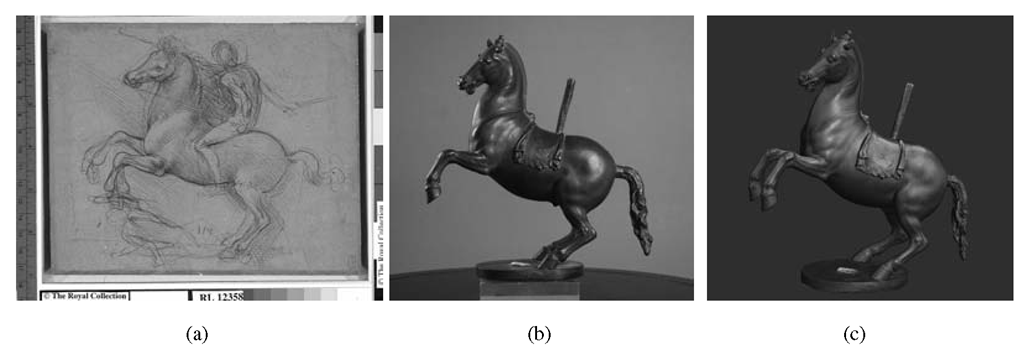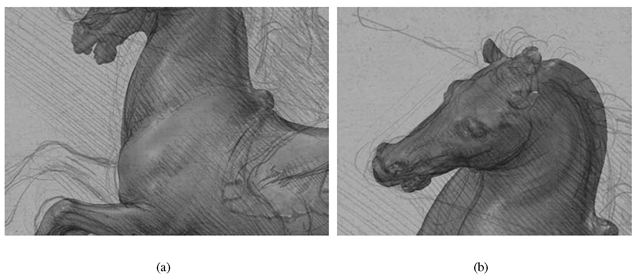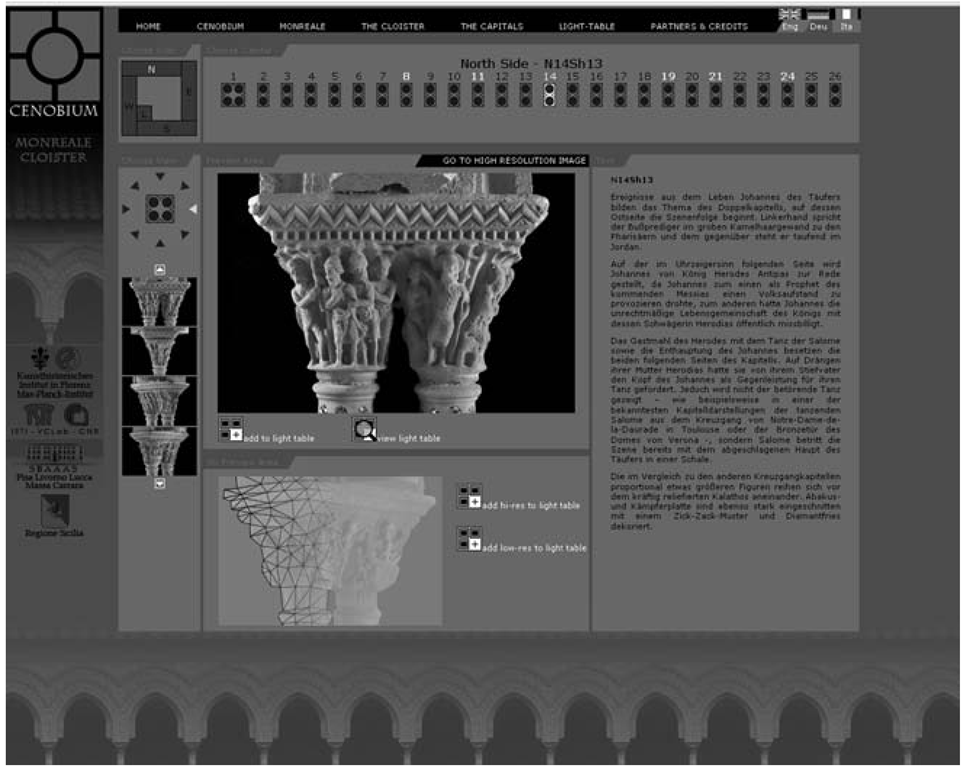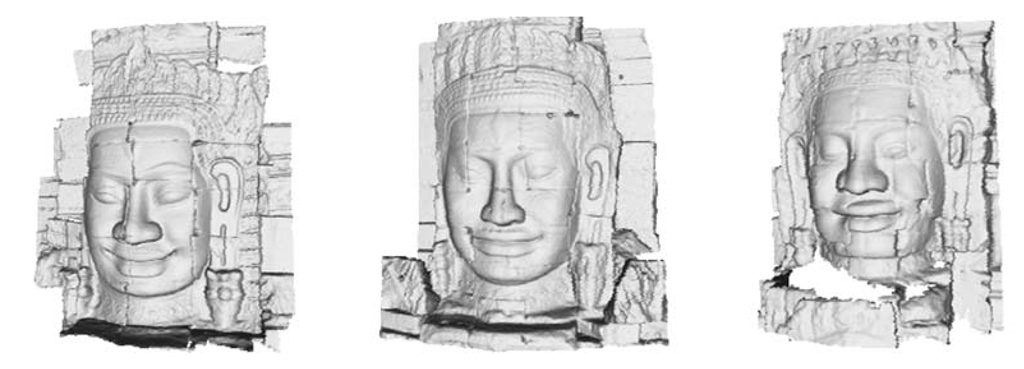Art Catalogs and Digital Repositories
CH cataloguing efforts are still based on just textual data enriched by (a few, often B/W) photographs. It is very easy to forecast a future where catalogs will adopt digital 3D models as the main representation resource for characterizing the shape and the appearance of the artifacts. Unfortunately, whether this will happen in a near or a far future depends more on the availability of funds and improved technological skills of the CH governing bodies than on technological reasons.
The wide availability of 3D catalogs is the prerequisite for devising interesting applications concerning 3D search and retrieval methodologies, able to find shape-similar artifacts in large digital repositories, given a sample object. A considerable research effort is now devoted to this topic; current solutions are too naive to work well in a field so demanding such as CH, but technology might improve fast. Moreover, the availability of 3D models of similar artworks can be very valuable to support further study, such as, for example, understanding how representation of God changed as the religion moved to different parts of the world [17] or supporting the assessment of attribution hypothesis [18]. While the current 3D scanning technology is considered mature for cataloguing efforts (even if the data encoding issue is still not completely solved, with so many alternative available 3D formats), some technical issues are still open, especially considering the problem of data preservation on long time frames. The usual problem (possible deterioration of hardware supports) is made more complex in the case of 3D graphics by the very fast renovation cycle of the software tools. This problem is less critical for repositories of basic 3D models than for the case of repositories for 3D interactive applications. In the first case, the adoption of publicly known and documented data format makes data obsolescence a more tractable problem. But this issue has to be considered and solutions have to be planned well in advance.
Finally, it is immediately evident how a CH repository focusing only on the storage and retrieval of 3D data is not enough [19]. CH applications require a joint management of the 3D model and of all the metadata which characterize the represented artifact. Moreover, it is strategic also to know how the digital 3D model has been acquired and how the raw sampled data have been processed to derive the final model. All this information is crucial to be able to assess the accuracy/quality of the digital model. These topics have been a major focus of the EU projects CASPAR (http://www.casparpreserves.eu/) and 3D-COFORM (http://www.3d-coform.eu/).
Digital 3D as a Tool for Art Scholars
Accurate 3D models and visualization tools enable very powerful means of presentation, inspection, or navigation of cultural heritage artifacts. But visual communication and insight is used also in several other applications or for other purposes. Important activities like proposing or validating the attribution of an artwork, planning and documenting restoration, and identification of fake artworks are based not only on material analysis [20-22] and historic documentation studies, but also on visual cues and comparisons between different artworks. Visual comparisons and localized annotation are also very useful for art historians.
FIGURE 2.6
(a) The Windsor silverpoint drawing (WRL #12358: The Royal Collection © 2007 Her Majesty Queen Elizabeth II). (b) The small bronze horse (Archeological Museum, Florence). (c) A snapshot of the model produced with 3D scanning.
Therefore, the digital 3D medium can become a powerful asset also for the work of the art scholars. The consolidated approach is to study an artwork by performing direct manipulation and visual inspection (which is a rare privilege of a very restricted number of experts, with heavy limitation in time and space). In many other cases, the work of the scholar is based on the analysis of 2D images, which present just a partial representation of the artwork (the information conveyed depends on the specific view depicted in the image and on the specific illumination used to make the photo). The digital 3D medium can offer a very similar experience to the personal manipulation to a much wider number of scholars (with no danger or deterioration for the original), from any location in space and at any time. Once an accurate digital 3D model is at disposal, there is the possibility to create arbitrary renderings from any point of view, giving to the scholars the possibility to locate and examine the important details as if they were manipulating the original artifact. In the next section, we show some interesting examples in this domain: the use of image registration techniques to support and attribution theory, the creation of a collaborative study environment for Romanesque Art, and the use of 3D data to classify faces sculptures in a Cambodian temple.
Using 3D Scanning to Analyze an Attribution Proposal
The work described here is a good example of how 3D technologies could be adopted to help the work of art scholars. It is also an example of application of techniques designed to solve a different problem: an image-to-3D model registration technique was applied to find a relation between a hand drawing and a bronze statuette [18]. The hypothesis proposed by Mark Fondersmith suggested that a Leonardo metalpoint (RLW #12358, Windsor Royal Collection, see Figure 2.6) could be an optically-traced drawing of a small bronze horse (inv. #19446, Archeological Museum, Florence, see Figure 2.6). According to this hypothesis, the small bronze horse should have been modeled much earlier than the official attribution (it is currently recognized as an artwork by B. Cellini). Fondersmith’s hypothesis went even farther, proposing that the small horse could have been cast by Leonardo, while an apprentice of Verrocchio (1470-1480). Later, Leonardo might have used the small bronze horse as a reference for the Windsor metalpoint (1480). According to this hypothesis, Leonardo could have used a camera obscura (or some other similar optical device) to create the
FIGURE 2.7
Images from the first alignment (main body).
FIGURE 2.8
Images from the second alignment (head).
Windsor metalpoint. The small bronze horse could have been traced in two stages: first, the body (see Figure 2.7) and then the head and one leg, drafted after rotating the bronze to the left (see Figure 2.8). The two sets of front hooves would be a true evidence of the rotation. The redrawn neckline might show how Leonardo reconciled the second angle of the head with the original profile. The precisely crosshatched areas of the drawing describe the sculptural form of the small bronze horse. The authors were contacted by Fondersmith for executing an accurate digital acquisition of the bronze, with the purpose of performing further study on a physical replica produced from the digital 3D model via rapid reproduction technology. After having acquired the digital model with 3D scanning technology (a screenshot of the colored model is shown in Figure 2.6), it was proposed to do some tests using a semi-automatic image registration approach [54].
In order to try to produce some scientific evidence of the asserted shape similarity, to help assess the attribution proposal, it was decided to treat the Leonardo’s drawing as if it was a photo. The alignment of the drawing to the geometric 3D model was performed in the usual way: some correspondences (points pairs) between the 3D model and the drawing were selected manually [54]. The correspondences on the drawing were set by following the indications provided by the attribution hypothesis. The two proposed points of view were considered: the first one for the body silhouette and the second, rotated one for the head and the right leg. Clearly, the points provided for the registration were different for the two cases. The focal length and perspective deformation was fixed to a plausible value for the use of a camera obscura. The result of the first alignment is shown in Figure 2.7, where the overlapping of the 3D model and the drawing is shown, progressively, with different transparency levels. As it can be noted, the alignment of some parts of the drawing is surprisingly precise: the lines of the neck and the back are coincident with the silhouette of the model, and the profiles of both fore and hind right legs are quite similar. Moreover, the position of the associated camera (denoted by a cone in the right-most section of Figure 2.9) is clearly compatible with the point of view of a person using a camera obscura.
FIGURE 2.9
The relative position of the camera for the first alignment is presented in the left image, while the relative position of the camera for the second alignment is in the right image.
FIGURE 2.10
Two detailed views: on the neck and saddle region (a) and on the head (b).
The second alignment was performed to validate the second proposed position, from which the head would have been sketched. Results are shown in Figure 2.8: not only the profile of the head is very similar to the drawing, but also the line of the neck is overlapped to an internal line in the drawing. The associated camera position (Figure 2.9) shows that the point of view is not only rotated but also raised with respect to the first alignment. The results of the alignment provided a visually significant proof and confirmed the compatibility of the use of a camera obscura to sketch the drawing from the bronze statue. It’s important to stress that no deformation was introduced while performing the image-to-3D mapping. Two images of zoomed-in details are presented in Figure 2.10. Unfortunately, it is very hard to provide numerical proofs of the quality/accuracy of an image-to-3D model alignment; this can be done with photos, which exactly reproduce the object, but it would be of no utility in this case, since the drawing is clearly not a mere numeric tracing of the silhouette but it is the hand of the artist that performs the tracing even when a camera obscura is used. Anyway, the surprising alignment obtained seemed to be too precise to be casual, especially considering the results obtained on similar objects that were tested.
In conclusion, this peculiar application showed that it was possible to provide some empirical proof to sustain the attribution proposal. Obviously, this is not the last word in the long lasting dispute relative to the attribution of the bronze horse, but it could help raise some serious concerns on the current attribution (i.e., to Benvenuto Cellini). The debate should be solved by further study or analysis of the constituent material and by a more in-depth study of the historical documentation.
FIGURE 2.11
CENOBIUM: integrated information about one selected capital.
The CENOBIUM Project: An Integrated Visual Comparison of Historiated Capitals
The CENOBIUM (Cultural Electronic Network Online: Binding up Interoperable Usable Multimedia) project [24] regards the visual comparison (for art history studies) of the Romanesque cloister capitals of the Mediterranean region. One of the goals of this project is to illustrate cultural exchange in the twelfth and thirteenth centuries through the example of architectural decorations. In this domain, three cloisters have been considered and digitized so far: the cloister of Monreale (Sicily, Italy), the cloister of Sant’Orso in Aosta (Italy), and the cloister of Cefalu (Sicily, Italy). Currently, the CENOBIUM website (http://cenobium.isti.cnr.it) includes the data about these three cloisters; we are planning to extend it in the near future. For most of the capitals of these cloisters several high-resolution digital images and highly detailed colored 3D models have been produced with different technologies, including laser scanning and image-based 3D reconstruction. The CENOBIUM website is a web application which attempts to integrate the different type of information about the acquired capitals. All the information related to a specific capital (text, images, and 3D models) are shown in a single web page (see Figure 2.11) to improve readability. Such information is handled through a database which inter-connects the different kinds of media (text, images, and 3D models). From the Capitals section the user has the possibility to explore, in an integrated manner, all the multimedia information related to each capital. By clicking on the selected view of the capital, we can visualize each full-resolution image. Since the resolution of the acquired images is very high, a dedicated image server (Digilib, developed by Max Planck Istitut) gives the possibility to navigate them interactively.
FIGURE 2.12
The visual comparison tool called LightTable [24]: on the left are the models downloaded locally, on the right the screenshot of the browser that allows inspection of the 3D model and three images of the same capital.
FIGURE 2.13
Three examples of carved faces in the Bayon temple. These models were used to classify the 173 acquired stone faces in three groups.
A textual description containing historical information is given in the right part. One of the most interesting features of the CENOBIUM website is the possibility to visually compare 3D models and images by selecting them during the navigation. The selected items are handled by the LightTable [24]: when an item is selected, the LightTable downloads it on the local PC; then, for those 2D or 3D items that are ready-to-use, the user has the possibility to visualize them simultaneously for the inspection. The maximum number of items that can be visually compared is four. Figure 2.12 shows the LightTable in use. The CENOBIUM system will be extended further, adding more data and functionalities; it could become a very useful resource for the work of art historians or art scholars. The most interesting goal of the whole project stands in the creation of a collaborative environment which is mainly devoted to art historians: the users will be able to compare 3D models and images from places which are disseminated around Europe. Moreover, the possibility to add annotations could boost the work of the small but active community of experts.






![The visual comparison tool called LightTable [24]: on the left are the models downloaded locally, on the right the screenshot of the browser that allows inspection of the 3D model and three images of the same capital. The visual comparison tool called LightTable [24]: on the left are the models downloaded locally, on the right the screenshot of the browser that allows inspection of the 3D model and three images of the same capital.](http://what-when-how.com/wp-content/uploads/2012/06/tmp874531_thumb.png)

